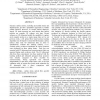Free Online Productivity Tools
i2Speak
i2Symbol
i2OCR
iTex2Img
iWeb2Print
iWeb2Shot
i2Type
iPdf2Split
iPdf2Merge
i2Bopomofo
i2Arabic
i2Style
i2Image
i2PDF
iLatex2Rtf
Sci2ools
ISBI
2009
IEEE
2009
IEEE
Quantitative Validation of Optical Flow Based Myocardial Strain Measures Using Sonomicrometry
Dynamic cardiac metrics, including myocardial strains and displacements, provide a quantitative approach to evaluate cardiac function. However, in current clinical diagnosis, largely 2D strain measures are used despite that cardiac motions are complex 3D volumes over time. Recent advances in 4D ultrasound enable the capability to capture such complex motion in a single image data set. In our previous work, a 4D optical flow based motion tracking algorithm was developed to extract full 4D dynamic cardiac metrics from such 4D ultrasound data. In order to quantitatively evaluate this tracking method, in-vivo coronary artery occlusion experiments at various locations were performed on three canine hearts. Each dog was screened with 4D ultrasound and sonomicrometry data was acquired during each occlusion study. The 4D ultrasound data from these experiments was then analyzed with the tracking method and estimated principal strain measures were directly compared to those recorded by sonomicr...
| Added | 19 May 2010 |
| Updated | 19 May 2010 |
| Type | Conference |
| Year | 2009 |
| Where | ISBI |
| Authors | Qi Duan, Katherine Parker, Auranuch Lorsakul, Elsa D. Angelini, Eiichi Hyodo, Shunichi Homma, Jeffrey W. Holmes, Andrew Laine |
Comments (0)

